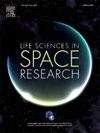空间辐射诱发辐射免疫鼠和适应鼠认知障碍的不同光谱
IF 2.8
3区 生物学
Q2 ASTRONOMY & ASTROPHYSICS
引用次数: 0
摘要
美国国家航空航天局(NASA)决定恢复载人深空飞行任务,首先是月球,然后是火星,因此有必要对宇航员在长期飞行任务中可能受到的健康影响进行详细评估。多项研究表明,空间辐射(SR)可能会对神经认知过程(包括高级执行功能)造成严重损害。然而,鉴于 SR 在中枢神经系统中诱发的变化多种多样,有可能在以前受到辐射的人身上诱发完全不同的 SR 后遗症。因此,目前的风险估计可能只适用于深空任务的早期阶段,即便如此,也只适用于以前没有太空经验的宇航员。在这项研究中,对初次暴露于 10 cGy SR(250 MeV/n He 或 GCRsim)后保持高注意力集合转移(ATSET)性能的大鼠,再暴露于 10 cGy GCRsim 剂量,并重新评估其 ATSET 性能。再次接受辐照的大鼠的 ATSET 表现明显受损,但其表现的下降在两个重要方面不同于通常在单次辐照后观察到的表现。首先,大鼠的成绩下降表现在需要进行成套移位时,特别是在 ATSET 测试的 IDR 和 EDS 阶段。其次,主要表现为处理速度的下降,在IDR阶段,再照射大鼠解决问题的时间是Sham大鼠的2倍。这种下降的功能性后果是,与假大鼠相比,受到 SR 暴露的大鼠在 20 秒内解决 IDS 和 EDR 问题的数量减少了 20%。因此,从使用未受辐射影响的大鼠进行的研究中得出的风险估计值可能无法充分反映在整个火星任务期间或多次返回深空的宇航员中可能出现的 ATSET 性能缺陷的发生率和性质。因此,对飞行任务期间在未受辐射大鼠和受辐射大鼠身上观察到的认知能力下降情况进行飞行中监测,并确保机组人员有足够的重叠技能组合,以尽量减少这些额外的认知障碍对操作的影响,是非常重要的。本文章由计算机程序翻译,如有差异,请以英文原文为准。
Different spectrum of space radiation induced cognitive impairments in radiation-naïve and adapted rats
NASA's decision to resume manned deep space mission, first to the Moon and then Mars, necessitated a detailed assessment of the potential health effects that astronauts may experience on long-duration missions. Multiple studies suggest that there may be significant space radiation (SR)-induced impairment of neurocognitive processes, including advanced executive functions. However, given the multitude of SR-induced changes in the CNS, it is possible that completely different SR-induced sequelae will be induced in previously exposed individuals. Thus, current risk estimates are likely to be pertinent only for the early stages of a deep space mission, and even then only for astronauts that have no previous experience in space.
In this study, rats that maintained high attentional set shifting (ATSET) performance after an initial exposure to 10 cGy of SR (either 250 MeV/n He or GCRsim), were exposed to an additional dose of 10 cGy GCRsim and their ATSET performance reassessed. The re-irradiated rats exhibited significant impairment of ATSET performance, however, the performance decrements differed in two important aspects from those typically observed after single exposures. First, the decrements were manifested when the rats were required to perform set shifting, specifically in the IDR and EDS stages of the ATSET test. Secondly, the main performance decrement was in a loss of processing speed, which in the IDR stage resulted in the re-irradiated rats taking 2-fold more time to solve the problem than did Sham rats. The functional consequence of this decrement was that compared to Sham rats, 20 % fewer SR-exposed rats solved the IDS and EDR problems within 20 s.
These data suggests that prior SR exposure alters nature of ATSET impairments from that observed in radiation-naïve individuals. Risk estimates derived from studies that use radiation naïve rats may thus not fully reflect the incidence and nature of ATSET performance deficits that could occur over the entire duration of a mission to Mars, or in astronauts who return to deep space on multiple occasions. It would thus be germane to conduct in-flight monitoring for cognitive performance decrements observed in both radiation naïve and exposed rats during the mission, and ensure that the crew has sufficient overlapping skill sets to minimize the operational impact of these additional cognitive impairments.
求助全文
通过发布文献求助,成功后即可免费获取论文全文。
去求助
来源期刊

Life Sciences in Space Research
Agricultural and Biological Sciences-Agricultural and Biological Sciences (miscellaneous)
CiteScore
5.30
自引率
8.00%
发文量
69
期刊介绍:
Life Sciences in Space Research publishes high quality original research and review articles in areas previously covered by the Life Sciences section of COSPAR''s other society journal Advances in Space Research.
Life Sciences in Space Research features an editorial team of top scientists in the space radiation field and guarantees a fast turnaround time from submission to editorial decision.
 求助内容:
求助内容: 应助结果提醒方式:
应助结果提醒方式:


